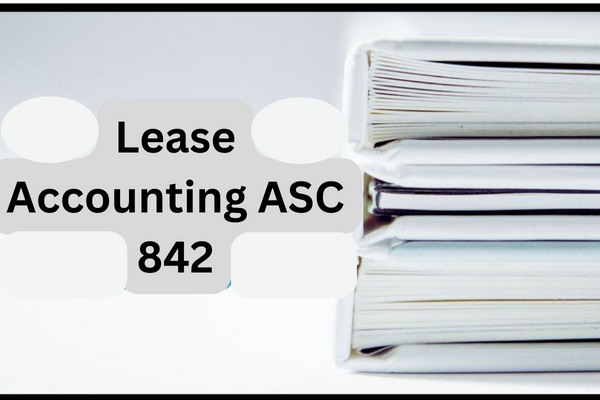Contents
Lease Accounting ASC 842, Understanding the New Guidelines and Compliance Requirements
Introduction of Lease Accounting ASC 842
Lease accounting under ASC 842 represents a significant shift in how organizations report their lease-related financials. The Accounting Standards Codification (ASC) 842, issued by the Financial Accounting Standards Board (FASB), introduces a comprehensive set of guidelines for lessees and lessors to follow. These guidelines aim to enhance transparency, improve comparability, and provide a more accurate representation of lease-related assets and liabilities.
In this in-depth guide, we will explore the key aspects of lease accounting under ASC 842, the implications for businesses, and the steps needed for compliance, ensuring a smooth transition to the new lease accounting standards.
Understanding Lease Accounting ASC 842
ASC 842, also known as the new lease accounting standard, revolutionizes how organizations recognize and disclose lease-related transactions in their financial statements. It replaces the previous standard, ASC 840, and aims to address the loopholes and shortcomings in lease reporting, providing stakeholders with a clearer picture of a company’s lease obligations.
Under ASC 842, lessees are required to recognize most leases on their balance sheets, classifying them as either operating or finance leases. This change ensures that the financial statements accurately portray the lessee’s right to use assets and associated lease liabilities.
Additionally, ASC 842 introduces new criteria for determining lease classification, updated disclosure requirements, and enhanced qualitative and quantitative disclosures. These changes aim to make financial statements more informative and accessible to users, including investors, creditors, and regulators.
Key Components of Lease Accounting ASC 842
1. Right-of-Use Asset (ROU Asset):
ASC 842 mandates lessees to recognize a right-of-use asset for all leases, reflecting their right to use the leased asset over the lease term. The ROU asset is measured based on the present value of lease payments, including any initial direct costs and other lease-related expenses.
2. Lease Liability:
In addition to the ROU asset, lessees are required to recognize a lease liability for all leases. The lease liability represents the present value of lease payments, discounted at the lessee’s incremental borrowing rate. The liability is adjusted for lease incentives, initial direct costs, and lease payments made.
3. Lease Classification:
ASC 842 introduces a new five-step model to determine lease classification. The lessee must assess whether the lease transfers ownership of the asset grants a purchase option, or covers a major part of the asset’s economic life, among other criteria. The classification determines whether the lease is treated as an operating or finance lease.
4. Lease Term:
ASC 842 defines the lease term as the non-cancellable period of the lease and any optional renewal periods where it is reasonably certain the lessee will exercise the option. The lease term also includes any periods covered by a termination option if the lessee is reasonably certain to exercise it.
5. Transition and Implementation:
ASC 842 allows lessees to choose between a modified retrospective approach and a cumulative effect adjustment upon adoption. Transition requirements may vary based on the entity type and reporting period.
Implications and Benefits of Lease Accounting ASC 842
1. Enhanced Transparency:
ASC 842 brings lease-related assets and liabilities onto the balance sheet, offering stakeholders a more comprehensive view of a company’s financial position and lease obligations. This increased transparency promotes better decision-making and risk assessment.
2. Improved Comparability:
By standardizing lease accounting practices, ASC 842 facilitates easier comparisons between companies and industries. Stakeholders can make more informed investment decisions and assess a company’s financial health accurately.
3. Better Lease Management:
ASC 842’s stringent guidelines prompt companies to reassess their lease agreements and optimize their lease portfolio. Businesses can identify cost-saving opportunities, negotiate better lease terms, and improve overall lease management strategies.
4. Impact on Financial Ratios:
The inclusion of lease liabilities on the balance sheet can impact financial ratios, such as debt-to-equity ratios and leverage ratios. Companies must be prepared to communicate these changes to stakeholders and investors.
5. Compliance Requirements:
Adopting ASC 842 requires a comprehensive review of existing lease contracts, data collection, software implementation, and staff training. Non-compliance may result in financial reporting errors and potential legal implications.
Steps to Ensure Lease Accounting Compliance ASC 842
1. Identify and Review Leases:
Companies must identify all existing lease agreements, including those embedded in service contracts, and evaluate them against ASC 842 criteria for proper classification.
2. Gather Data and Information:
Accurate lease data, including lease terms, lease payments, renewal options, and other lease-related information, must be collected and organized for accurate calculations.
3. Choose a Transition Approach:
Decide on the transition approach – modified retrospective or cumulative-effect adjustment – based on the company’s needs and reporting period.
4. Invest in Lease Accounting Software:
Lease accounting software can streamline the compliance process, facilitate accurate calculations, and ensure proper lease management going forward.
5. Educate and Train Employees:
Properly educate the finance team and relevant stakeholders on ASC 842’s requirements and implications to ensure seamless implementation and compliance.
Conclusion
ASC 842 lease accounting marks a significant step forward in lease reporting, promoting transparency, accuracy, and comparability in financial statements. By recognizing lease assets and liabilities on the balance sheet, companies can provide stakeholders with a clearer understanding of their lease obligations. However, compliance with ASC 842 requires careful preparation, data organization, and the adoption of lease accounting software. Companies that embrace the changes brought about by ASC 842 will not only achieve compliance but also gain valuable insights for better lease management and informed decision-making in the ever-evolving world of finance.

Leave a Reply